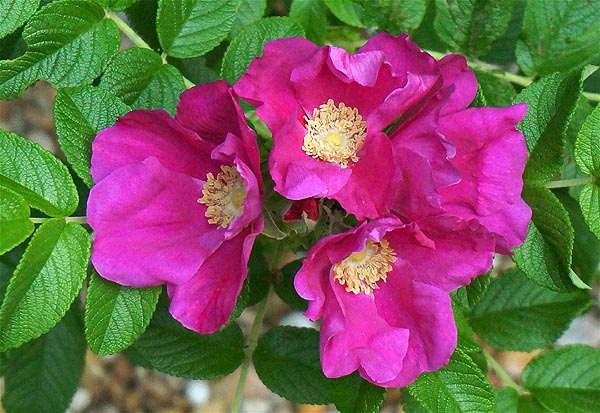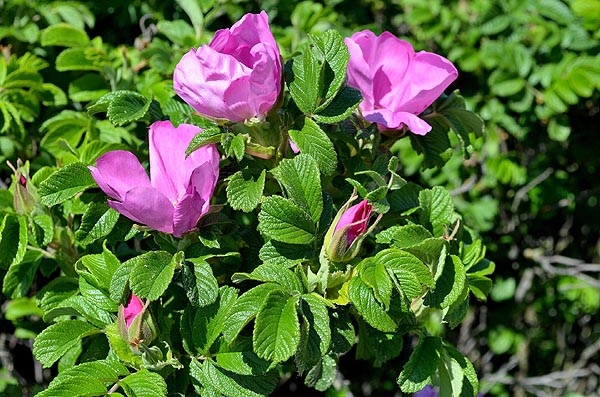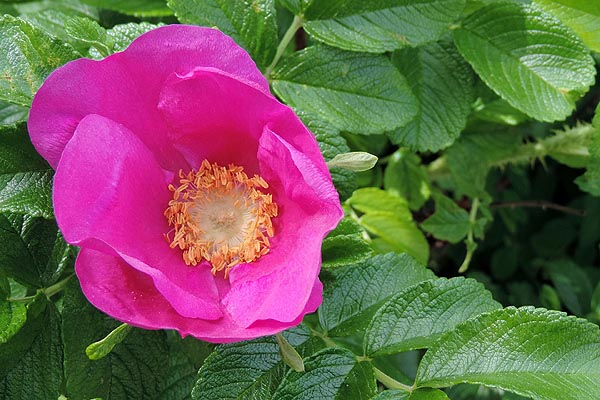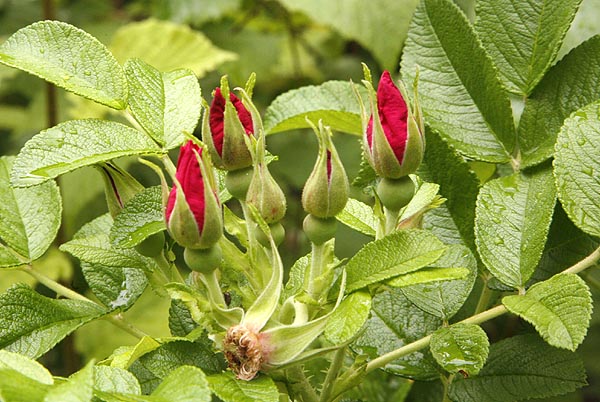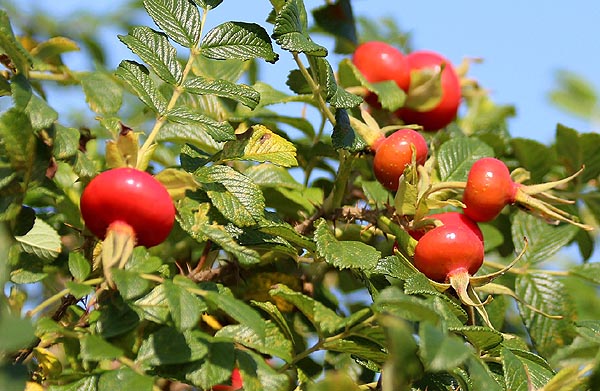A truly beautiful plant that is usually in a rose that it will grow true from seed. It does not need much care or maintenance once established and flowers prolifically for long periods of time. Its extremely rugged (hence its name) it will grow on almost any soil even pure sand but does not like wet soils. It needs full sun to be at its best but will take a little shade. Extremely hardy down to zone 3 it is very drought tolerant. It laughs at high winds and salt living happy on wind scoured beaches and flowering in beach sand. The beautiful pink or sometimes white flowers can be 4" across and are very aromatic which attracts butterflies and bees. Its followed by the largest hips of any rose which is wonderful for making rose hip products or just letting the birds enjoy them through the winter as they stay red on the bushes for months. Even those who are not that keen on roses will like this plant. You can plant and forget it except for enjoying the flowers. May need a little pruning in spring depending on your zone, in some you can just mow it down for the winter. The hips (fruit) are very high in Vitamin C as well as other essential compounds your body want to stay healthy so plant some this year and enjoy.
We have not found that scarification, soaking or other treatments make any difference to the amount of seeds that germinate. Some seeds may germinate without stratification just by being left in the refrigerator for a period of time. All our seeds are stored in cold conditions to help with this process.
We recommend sowing in small individual pots or a tray of cell pots and either leaving outside during the winter or placing in a cold shed or garage for the winter months. Sow 1-2 seeds per pot for a 2 inch (5 cm) pot. Whatever your method make sure that the pots stay moist. If placing indoors wrapping in a large clear plastic bag will help keep the soil moist during the winter months. This method does not work as well outside as the plastic tends to become ripped by birds, falling twigs, leaves and other means. So if keeping outside make sure they are close enough to the house that you remember to water them and keep moist as outside pots tend to dry out rapidly.
If placing outside take care to protect seed trays as rodents will dig up the seeds and eat them.
Once the seeds have stratified germination is usually fairly successful. Percentage rate is usually 60-80% but will depend on the conditions you use. Not all seeds will germinate but if you are patient though another year they usually come up in the second year.
Once seedlings have germinated treat as any other seedling. It is usually best to repot seedlings into larger pots and grow on to about 12" tall (30 cm) before transplanting to their desired location. This usually takes a couple of months but the plants are very fast growing.
They are extremely hardy up to zone 3 and can tolerate salt, even salt spray and will grow right on the beach if the opportunity arises. They are also very drought tolerant but do need a period of cold in the winter to stimulate growth so don't do as well below zone 7b. Often flower in the second year from seed.
The size the plant grows to will depend on your zone. In cold zones the plant can die back to the ground entirely in winter, in mid range zones it will keep a couple of branches and warmer it may behave like any other rose bush. Thus plants that die back will not reach the same size as one that was already a fair size going into winter. Plan and plant according to your zone.
The best time to harvest is just after the frost, however if you plants are producing hips early you may need to harvest some sooner or they could dry up and be lost. Fruits should still be soft maybe a little wrinkly but not to much, if they are all soft you have waited too long and they are rotting. Cut the hips off just behind the fruit using scissors or floral snips (my choice these things are great). How you then proceed will depend on what you are doing with the hips.
In the right location diseases can include: Black Spot, Powdery Mildew, Rust, Aphids, Scale and Spider Mites. Deer will eat them to the ground if they can.
Most recipes for using hips use only the fleshy part of the hip with the seeds removed. The seeds are covered in little hairs which can be very irritating in processed into a food. If cooking do not use any metal pans or utensils other than stainless steel or risk discoloration of the fruit and loss of its precious vitamin C stores. The most commonly made items are syrups, jams and jellies sauces or a rose hip butter of puree and sweetener.
The flower petals are also edible are excellent in omelets, fried in batter, crystallized, added to soups, salads, or processed to make jelly, syrup or rosewater. A tea can also be made from the leaves.
While most sources state that the seeds should be removed before using the fruits recent research has found far more benefits in leaving the seeds in and using the whole fruit. Fruits used in this way are dried and then turned into a power before use which eliminates the problem with the irritating hairs. In this form they are being used to treat some cancers and hepatic disorders.






